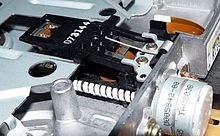
Back Barra roscada Catalan Gevindspindel Danish Gewindespindel German Ira ŝraŭbaĵo Esperanto Tornillo de potencia Spanish Torloju-azkoin Basque پیچ انتقال قدرت Persian Système vis-écrou French すべりねじ Japanese Ledeskrue NB

3 & 4: buttress thread
5: round thread
6: square thread


A leadscrew (or lead screw), also known as a power screw[1] or translation screw,[2] is a screw used as a linkage in a machine, to translate turning motion into linear motion. Because of the large area of sliding contact between their male and female members, screw threads have larger frictional energy losses compared to other linkages. They are not typically used to carry high power, but more for intermittent use in low power actuator and positioner mechanisms. Leadscrews are commonly used in linear actuators, machine slides (such as in machine tools), vises, presses, and jacks.[3] Leadscrews are a common component in electric linear actuators.
Leadscrews are manufactured in the same way as other thread forms: they may be rolled, cut, or ground.
A lead screw is sometimes used with a split nut (also called half nut) which allows the nut to be disengaged from the threads and moved axially, independently of the screw's rotation, when needed (such as in single-point threading on a manual lathe). A split nut can also be used to compensate for wear by compressing the parts of the nut.
A hydrostatic leadscrew overcomes many of the disadvantages of a normal leadscrew, having high positional accuracy, very low friction, and very low wear, but requires continuous supply of high-pressure fluid and high-precision manufacture, leading to significantly greater cost than most other linear motion linkages.[4]
- ^ Ball Screws & Lead screws, retrieved 2008-12-16.
- ^ Bhandari, p. 202.
- ^ Shigley, p. 400.
- ^ US 5499942, Pflager, William W., "Hydrostatic nut and lead screw assembly, and method of forming said nut", published 1996-03-19, assigned to Western Atlas Inc.
© MMXXIII Rich X Search. We shall prevail. All rights reserved. Rich X Search